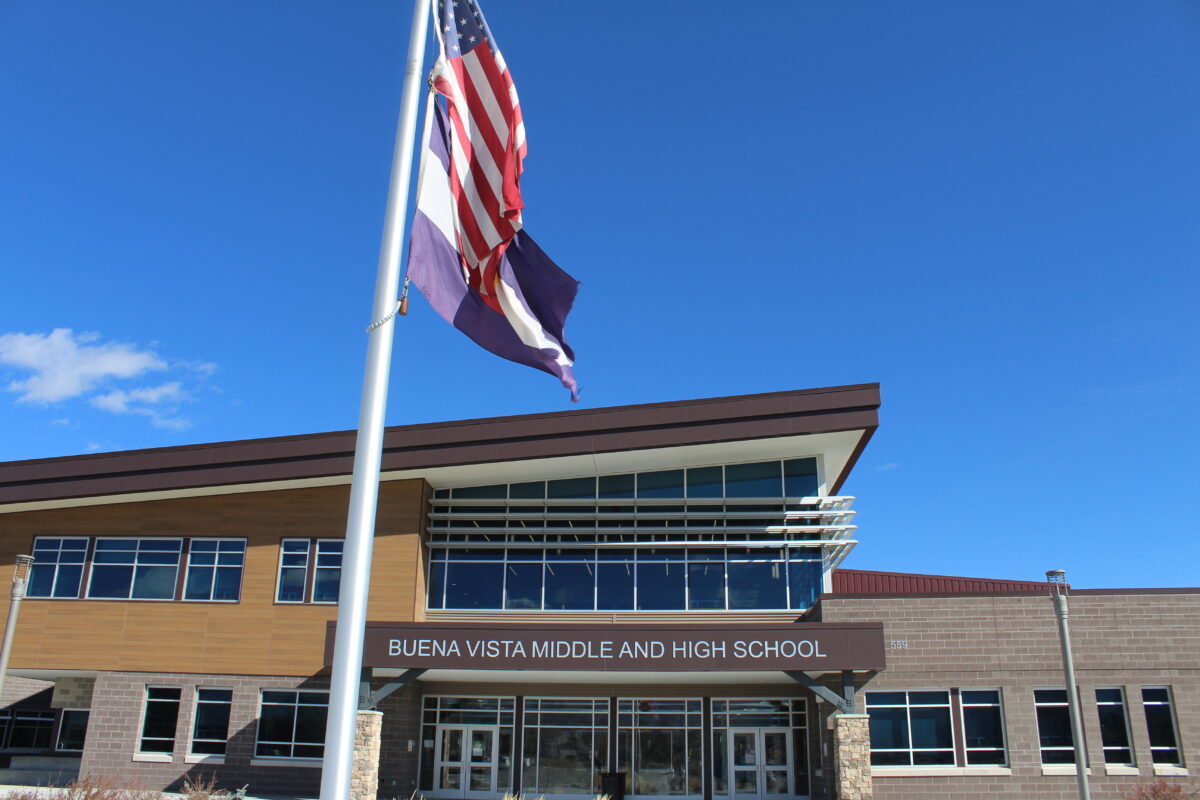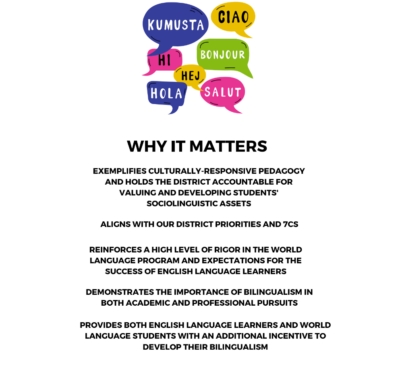
Buena Vista Middle and High School. Photo by Carly Winchell
Culturally and Linguistically Diverse (CLD) students, known more commonly as English Language Learners (ELL), were a big topic at Monday’s Buena Vista Board of Education meeting. The Board heard reports and evaluations from multiple programs, but a big focus in the community lately has been on ELL.

Buena Vista School District Logo courtesy bvschools.org
Elementary ELL Teacher Nancy Jones was the primary presenter on the ELL program alongside High School Spanish Teacher Angelee March. Jones is set to retire at the end of the year.
There are 41 students in kindergarten through twelfth grade who qualify for English Language Development services. Qualified non-English Proficient (NEP) and Limited English Proficient (LEP) students amount to 4.33 percent of the student population, up 2.8 percent from the previous school year. Languages spoken by students include Spanish, Mandarin, Albanian, Nepalese, Russian, Mongolian, Luxembourgish, and Amharic.
Of qualified students, approximately 78 percent indicated Spanish at home.
This amount does not count the work for the program team to screen all incoming students who identify a language other than English for eligibility, assist families with translation services, or exit monitoring for students who leave the program.
The word “newcomer” was used frequently during this discussion. It has a specific definition per the Department of Education, “According to the U.S. Department of Education (2023), newcomers refers to K-12 students born outside the United States who have arrived in the country in the last three years and are still learning English. The term newcomer families refers to the families or guardians of these students.”
In Kindergarten through fifth grade, there are 16 newcomer students, 12 of whom enrolled this year. As of Monday, there was at least one newcomer student in every grade in elementary.
In sixth through twelfth grade, there are four newcomers. The number fluctuated between four and six students throughout the year. District-wide program development for a newcomer program began in January of this year.
According to the highlights slide of the presentation, “Teachers and staff have gone above and beyond to support a quickly-changing population and have demonstrated individualized care for students and families as well as flexibility and a willingness to learn and adapt to change.”
The community as a whole received praise for embracing newcomer students and their families.

Biliteracy certifications are now available for BV School District students who are proficient in more than one language. Image courtesy of the August 28 Buena Vista Board of Education meeting packet.
March also explained that students are more immersed in other languages than ever, detailing how a group of soccer team girls came and asked for translations for soccer terms to improve communication with a member of the team. “They take turns going to pick up their teammate and take her to practice. Those sorts of things are really incredible.”
Jones emphasized the importance of the teachers who have embraced newcomer students despite language barriers and limited resources at the schools to provide all the necessary services. She said it had been rewarding to watch staff grow to accept and welcome newcomer students rather than worrying over how to communicate.
“I’m just so proud,” praised Jones.
One highlight focused on the benefit of these students and their families to the community. “Newcomer students and families have contributed cultural and linguistic assets to our community and our classrooms which helps our entire student population prepare to interact with a diverse world,” states the presentation.
Despite these highlights, staff were realistic about the limited resources, saying it has been “extremely challenging” to meet the needs of newcomer students with limited staff and resources.
“We are in need of more qualified CLD specialists and bilingual staff, as well as professional development, to adequately serve our changing student population,” explained March.
“While we have made progress with equitable communication, we are still struggling to provide adequate translation and interpreting for enrollment, communications, meetings, activities, conferences, and more.”
March said, “Translation has been a big need for a while, but this is starting to feel really urgent.” As the number of newcomer students and families grow and it becomes less feasible for staff to contact all individually during events such as snow days, the needs will only grow as well.
“Just because it’s out there, doesn’t mean it’s culturally accessible to families or that they know how to use it. That’s why a fully developed newcomer program is so important,” said March.
Board Vice President Brett Mitchell suggested the increased numbers will only continue to grow over the coming years. “Unfortunately, we’re in a situation where I expect we’re going to see another big rush next year and the year after,” said Mitchell, without qualifying any factual basis of his comment.
In response, Jones encouraged the Board and the district as a whole to embrace newcomer students.
“I encourage you all to embrace it. That’s been what I’ve done my whole career. They bring such joy and enthusiasm. And you know there’s nothing greater than a child who’s here because their family still has that American Dream of a better life and that education is everything…Everything to them,” said Jones.
“It’s going to make our entire district better. It already has,” said March.
Later in the meeting, Superintendent Lisa Yates delivered the program evaluation of ELL. When discussing the program’s belief statement, she said the focus should be on what CLD students can do, which is contribute to the vibrancy of the schools.
“Buena Vista School District believes CLD learners bring a unique set of assets (linguistic, cultural, and experiential) that enrich the experiences of all learners and educators. By focusing on what CLD learners can do and encouraging multilingualism in our schools, educators send a powerful message that students from diverse linguistic, cultural, and experiential backgrounds contribute to the vibrancy of our schools,” states the program guide, which is the beginning of how the district will document how the program will run.
She mentioned commendations for the program for its flexibility and the fact that current practices address the whole child and match current research.
Recommendations emphasized the need for more professional learning to help staff be prepared to work with newcomer students and continue staff growth.
Yates and staff will be working on the newcomer program guide and exploring how that fits with a program of Buena Vista’s size.
School Financing and CLD Students
During Board Correspondence, Mitchell mentioned a phone call that afternoon with a concerned community member referencing a state-level proposal.
“Is there a bill or proposal going through the state right now. . . talking about is there some proposal out there that the state is trying to take the school budget formula and take a piece of it out to start paying for newcomers?” asked Mitchell.
The concern was that the proposal was attempting to take the budget formula for schools and take out a piece of the money to to provide funding for newcomer students.
Yates quickly clarified that this was not the case, and that the proposal for school year 2025 to 2026 contained an extra multiplier for ELL, special education, rural, and other students to calculate funding.
Yates said people may interpret the proposal in the way suggested; however, no funding would be taken away from districts. She also said there was communication about distributing funding for students who enrolled after October 1. Yates said this email communication would have been easy to miss.
The proposal referenced in the communication with Mitchell is likely Senate Bill 188, which will provide an increase in funding to districts per student next year and specifically devotes more money to rural districts. Colorado is thirty-fifth in per pupil funding in the country.
According to the Colorado Department of Education, the inclusion of ELL students in the funding year began under SB21-268 and began with the fiscal year 2021 to 2022. This funding factor included additional funding to districts tied to the “total number of English language learners included in the district’s funded pupil count for the current year.”
The 60-page report released earlier this year, S.B. 23-287 Public School Finance Task Force Report, provided recommendations for overhauling the school funding formula. One recommendation, out of many, in that report was, “to increase ELL weight to at least .5 on total possible ELL weight. Starting in FY 2024-25 there will be no eligibility cap for students.”
Essentially the recommendation was intended to increase funding for districts based on ELL student counts by upping the multiplier in the formula used to calculate school funding which involves multiplying a base, per-pupil amount by various factors and multipliers to calculate the exact amount of funding schools will receive.
For more information on what’s happening in the Buena Vista School District, community members can read the April BV Monthly. The BV Monthly newsletter includes a superintendent letter, BV and what’s in the news, event announcements, and other information about the district. It is available to read on the school’s website.
The Monday, April 8 Board of Education meeting agenda and packet link is also available online.






Recent Comments